How to Eat Korean Food (Without Embarrassing Yourself)
Don't let the impressive spread at a Korean meal intimidate you. Here's how to tackle banchan, ssam, and more.
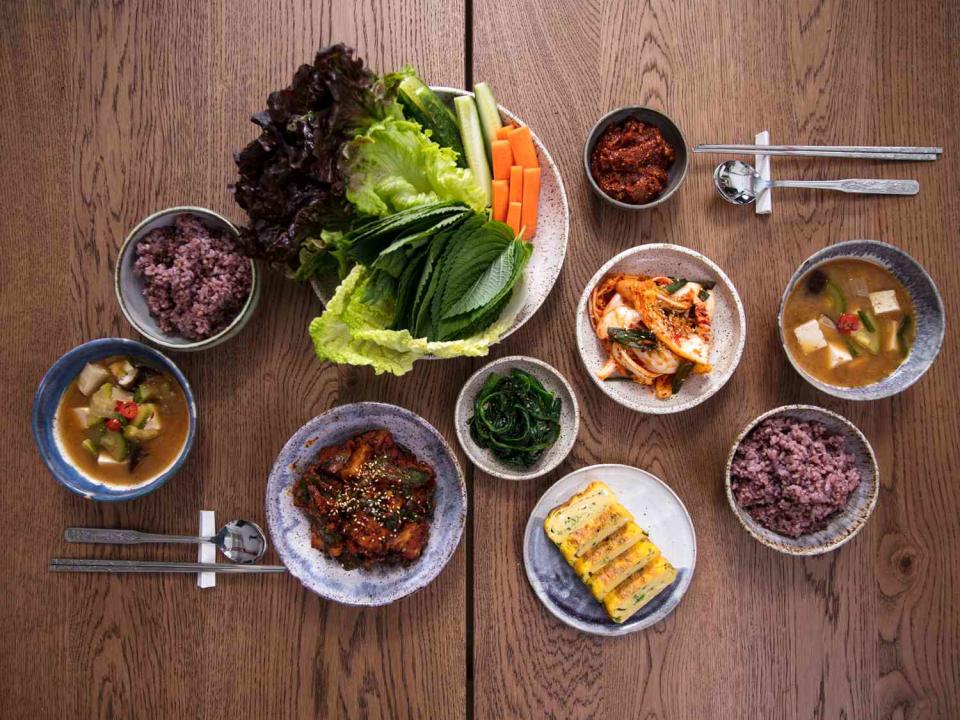
Serious Eats / Vicky Wasik
The best part of learning about new cuisines is trying delicious dishes and ingredients that are entirely new to you. And an important element of any cuisine is the customs and etiquette that govern how meals are eaten.
More often than not, customs concerned with the way food is eaten are meant to heighten the diner’s enjoyment of a meal. You may be one of those monsters who use a knife and fork to eat a classic NYC slice of pizza, but everyone knows the best way to enjoy a slice is to fold it in half and tilt it into your mouth; the method increases a slice’s portability, makes it neater to eat, and helps funnel all that delicious pizza grease down your throat.
That’s not to say that we here at Serious Eats believe that there’s a right or wrong way to enjoy food of any type (you do you, knife-and-forkers!). As long as whatever you’re eating makes it to your mouth, you’re doing fine. But we do think there is a best way to enjoy specific dishes or meals.
To that end, we asked chef Seoyoung Jung—who’s already shown us how to stock a Korean pantry and has shared a bunch of wonderful Korean recipes on our site—to walk us through the customs and etiquette that govern a typical, home-style, Korean meal. The result is the instructive video below.
A small caveat: Seoyoung took pains to note that the guidelines below are more of a sketch than prescriptive requirements, and that, in Korean cuisine, as in every other, there are many kinds of meal formats.
Cutlery
One of the first things you may notice upon sitting down to a Korean meal is the cutlery. Korean place settings will always have both chopsticks and a spoon. Unlike their Chinese or Japanese counterparts, Korean chopsticks are flat, not rounded or pointed, and are typically made from metal.
Koreans also tend to use the spoon instead of chopsticks for eating rice. Because of that, it’s considered rude to lift the rice bowl when eating from it, as is common in, for example, Japan, where lifting your rice bowl while using chopsticks to pick up the rice is incredibly common.
Lifting other plates off the table in order to eat from them is also considered impolite.
Rice: The Main Course
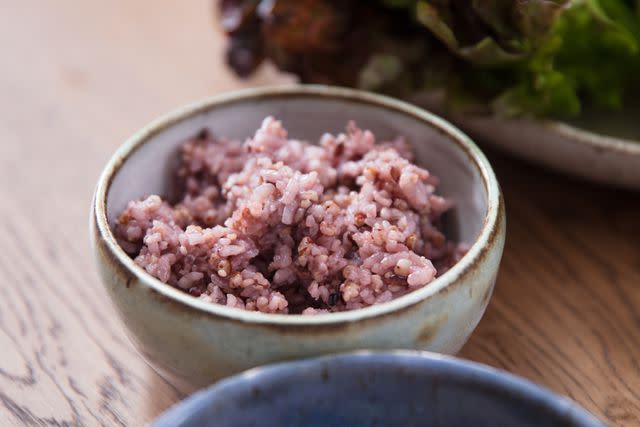
Serious Eats / Vicky Wasik
Another thing you’ll notice anytime you sit down for a meal is the central importance of the bowl of rice, which anchors the entire meal. Far from being considered a side dish, rice is essentially the star, as is common in many other Asian countries. Every other element of the meal serves as an accompaniment for the rice.
Banchan: Side Dishes Galore
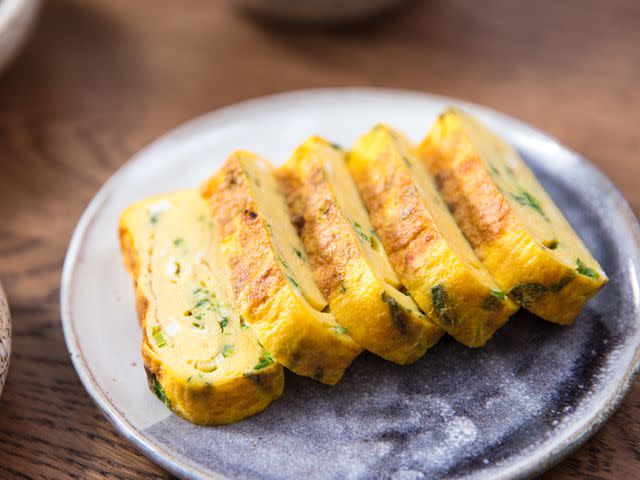
Serious Eats / Vicky Wasik
Anyone who’s had the pleasure of eating at a Korean barbecue restaurant will be familiar with banchan, the large collection of preparations that are plonked on the table as soon as you order. Banchan aren’t really meant to be treated like appetizers or condiments, though. Instead, they can be loosely described as "side dishes." The banchan category includes the whole class of pickled preparations that fall under the broad term of "kimchi," but it also can include everything from potato salad and stir-fried dried anchovies to namul, or simply dressed blanched vegetables, like bean sprouts or spinach.
Banchan provide a fair amount of variety to every meal, Seoyoung says they are meant both to serve as accompaniments to the rice and as relievers of palate fatigue—the rolled omelette pictured above is a perfect example, meant to offset the spicy pork, the savory stew, and the other more boldly flavored banchan. A full spread will typically have at least a few, balanced banchan, although more elaborate meals can be served with as many as 10, 15, or even 20 different banchan.
A Soup or Stew
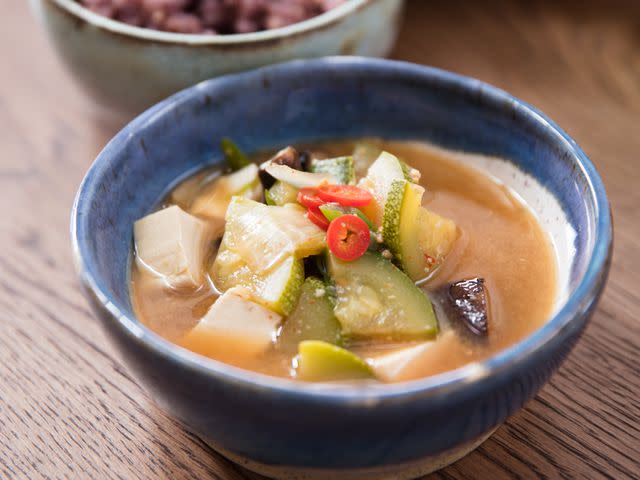
Serious Eats / Vicky Wasik
Rice and banchan are typically served with a soup or stew alongside. Seoyoung notes that the main thing to be aware of is where you place your soup bowl in relation to your rice bowl. Etiquette dictates that the rice bowl should always be to the left of the soup/stew bowl. Putting the rice bowl to the right of the soup/stew bowl symbolizes death, and is typically only seen during meals in which Koreans are celebrating their deceased ancestors.
Like everything else on the table, the soup or stew is meant to be eaten with rice, but how you choose to eat it is largely up to you. Some people will choose to tip a fair amount of rice into their soup, creating a kind of porridge-like consistency, whereas others will alternate sips of soup or bites of stew with mouthfuls of rice. You can read more about the funky, spicy world of Korean soups and stews here.
A Meaty Side Attraction
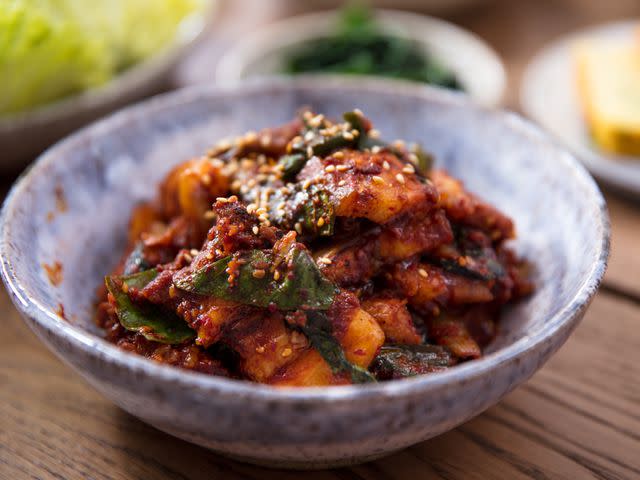
Serious Eats / Vicky Wasik
In many Western meals the protein is the centerpiece of the meal, but when Seoyoung prepared stir-fried pork belly for us, she explained that it’s again meant to be a supporting player for the rice.
Having a protein-rich dish, whether it features meat, seafood, or tofu, isn’t a requirement, but it is increasingly common. Hearty meat dishes are typically also accompanied by ssam, leafy vegetables like perilla leaves, cabbage, and lettuces that can be used to create small, delicious packages of meat, rice, and flavorful accoutrements, like raw sliced garlic and ssamjang. To try some at home, give Seoyoung’s bossam recipe a shot.
Seoyoung says it’s polite to keep your ssam-package small enough to be eaten in one bite. A corollary of that rule is you want to make sure the different elements you pack into a ssam are roughly proportionate, so you have a balanced bite. For example, if the pork you’re eating is highly seasoned, exercise a little restraint on the ssamjang; if you grab a small piece of pork, don’t overwhelm it with a large pile of rice; etc.
Enjoy Your Meal!
Armed with this knowledge, you shouldn’t encounter any obstacles to enjoying a home-style Korean meal to the fullest extent possible. As in any culture, be sure to thank your host.
June 2019

